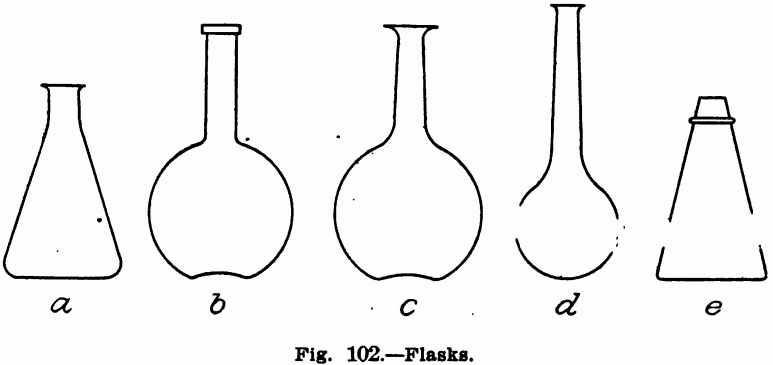Laboratory Flasks may be obtained in some fifteen or twenty different forms, of which the Erlenmeyer and the globe are most used in analytical laboratories. The Erlenmeyer is shown in a, Fig. 102. It is an excellent flask in which to filter by suction (see Chapter III.), for titrations, where precipitates are to be formed in a flask by shaking, etc., and from which to filter by decantation. Flasks to be used with suction should be heavy enough to stand heavy pressure. A very heavy Erlenmeyer with a side neck is made especially for this purpose. For most work an Erlenmeyer with a rather wide mouth will be found convenient. These flasks are made as large as 1 gallon and as small as 1 ounce capacity and can be obtained up to 32 ounces with ground glass stoppers, or with a pour out.
Globe flasks, b, Fig. 102, are made in sizes ranging from ½ ounce to 5 gallons, and with round or flat bottoms. When they are to bear corking they should have what is known as ring-

finish necks, that is, a heavy ring of glass around the neck, as shown in b. The inside edge of the ring should also be ground off to prevent cutting of the stopper. When the flask does not have to be corked a vial mouth may be used, c, Fig. 102. For wash bottles (Chapter V.) the ring-finish, flat-bottomed flask should be used.
A small conical flask having a ring around its upper end and known as an “assay flask” or “matrass,” Fig. 102, is used in parting gold bullion. A round bottom flask, d, Fig. 102, with a long neck, made of hard Bohemian glass, is used for nitrogen determinations by Kjehldahl’s method. Globe flasks, both with flat and round bottoms, having side necks, are used in making boiling point determinations and also for determining substances by evolution and distillation methods.
Any of the foregoing flasks may be obtained made of any glass desired, Kavalier’s, Bohemian, Baloc, Nonsol, Jena, etc. (see Beakers).
